Archeological Data Indicates that the University of West Florida’s “Luna Colony” is Actually a Native Village
by Caleb Curren
April 2021
The first mission of a newspaper is to tell the truth as nearly as the truth may be ascertained.
The Washington Post.Archaeology is not what you find, it’s what you find out.
The American Museum of Natural History.
The public is influenced by news reporting, be it accurate, partially accurate, or altogether false. That reality has been demonstrated throughout history and into the present. When journalism loses its objectivity it
ceases to become journalism and morphs into promotialism. Scientifically, when research is conducted based on a preconception of the outcome and ignoring the data recovered … it becomes invalid.
Beginning in 2015 a number of local news media became aware of the University of West Florida (UWF) claim that the East Pensacola Heights Site (8Es1) is the location of the Luna Colony. The Pensacola News Journal (PNJ) published articles claiming that UWF had unquestionably found the site of the 1559 Luna Colony. The following is a sample list of the PNJ titles of their articles. The PNJ author of these and other
articles subsequently became an employee of UWF in 2017 under the title of “News and Publicity Director for Institutional Communications.”
“ We Found Luna’s Colony” 12/18/2015.
“Neighbors excited to be part of Luna history” 12/18/2015.
“Don Tristan de Luna Settlement, Historic Discovery” 12/20/2015.
“It’s a Crowning Achievement for UWF president” 12/20/2015.
“Archaeologist ‘Worth’ every penny for UWF” 12/20/2015.
“Luna Site is in the Spotlight” 1/7/2016.
Even The New Yorker magazine joined the promotional effort to publicize the UWF alleged Luna Colony discovery (4/9/2016). Their article was entitled “Uncovering the Luna Colony, A Lost Remnant of Spanish Florida.”
These articles from local and national media were prematurely published prior to conclusive scientific data that would prove or disprove the UWF claim. True scientific inquiry is not determined in newsrooms with deadlines pushing for dramatic stories to sell the news, rather, scientific inquiry is conducted based on the rudimentary concept of hypothesis development and testing. A hypothesis is a tentative assumption made in order to draw out and test its logical or empirical consequences. UWF and the news media have not adhered to this process.
True scientific inquiry is slow, methodical, cautious, and deliberate. Viable hypotheses are developed in labs, libraries, internet searches, debates with colleagues, round table discussions, emails, and peer reviews. The hypotheses are then rigorously tested through fieldwork and objective interpretation of data recovered. The UWF policy of presenting premature papers at numerous archeological conferences around the country does not equate to publishing a detailed technical report of six years of UWF fieldwork at the East Pensacola Heights Site supported with indispensable facts.
While it is true that UWF has recovered an impressive array of 16th-Century Spanish artifacts on their alleged Luna Colony site, it is certainly not clear how the artifacts arrived there. The Smithsonian Institution during the late 1800s and again in the 1940s noted that the site was a Native village with two burial mounds and occupational midden remains. Which group brought the Spanish artifacts to the site? Natives? Spanish?
A reasonable hypothesis is that the Spanish artifacts were brought to the Native village through trade and / or salvage by the Natives themselves during and before the Luna Expedition. Another hypothesis is that the Spanish artifacts could even have been left by Spanish salvors camped on the site while they attempted to recover objects from their three unanchored shipwrecks just offshore.
Archeological evidence of the settlement plan of the Viceroy of Mexico for the Luna Colony has not been found at the site. Remains of a church, a graveyard, a king’s warehouse, a plaza, and Spanish domestic structures, all required for proof of the Luna Colony, have not been reported from the East Pensacola Heights Site. Conversely, Native burial mounds, middens, pottery, and burials have been found. Thus far, the archeological evidence of a Native village at the site outweighs that of the Luna Colony.
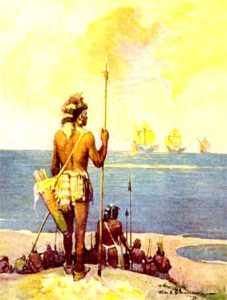
Figure 1: Natives viewing Spanish sailing ships from their village area.
Courtesy of Parris Island Museum.
UWF added credence to this Native village reality by noting that approximately 70% of pottery sherds excavated by them from portions of the site were Native in origin (See “Functional and Spatial Patterning in Artifact Distribution at the Luna Settlement Site,” by UWF John E. Worth, Florida Anthropological Society, Crystal River, Florida, May 11, 2019). Nonetheless, UWF continues to “declare” that the site is the Luna Colony.
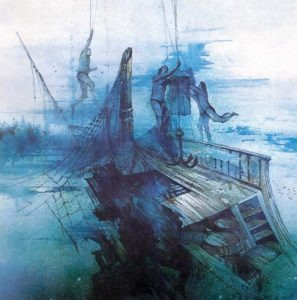
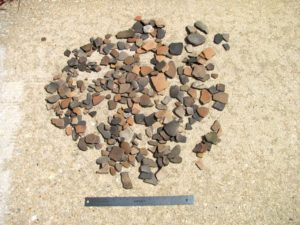
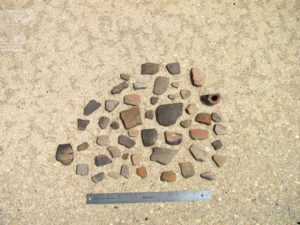
Figure 3: Photographs of a sample of Native ceramics recovered by CAI personnel along the eroded shoreline of the East Pensacola Heights Site (artifact list on following page). The Native ceramics date from the Woodland and Mississippian Periods (Santa Rosa / Swift Creek, Weeden Island, Ft. Walton, and Pensacola) including the period of the Luna Expedition in Pensacola Bay.
The importance of the ceramics indicates that the site was used as a village, either permanent or seasonal, by generations of Native groups as confirmed by the research of the Smithsonian, CAI, and UWF. The Native people likely traded with European sailing expeditions during first contacts of the 1500s and perhaps salvaged artifacts from the three Luna shipwrecks that washed upon the adjacent shallows during the hurricane of 1559.
Based on the fact that the site was definitely a Native village, it is inappropriate to jump to the conclusion that the site is the Luna Colony. Rather, hypotheses should be developed and tested. Three of these hypotheses include:
Hypothesis #1: The site is the Luna Colony.
Necessary Proof: Spanish burials, structures, firehearths, refuse pits.
Hypothesis #2: The Spanish artifacts at the site came from trade and salvage by the Native inhabitants.
Necessary Proof: Lack of Spanish features. Only Native features present. Spanish artifacts scattered amongst Native artifacts.
Hypothesis #3: The Spanish artifacts found came from a short-term Spanish shipwreck salvors camp.
Necessary Proof: Lack of numerous Spanish features. Spanish artifacts scattered amongst Native artifacts.
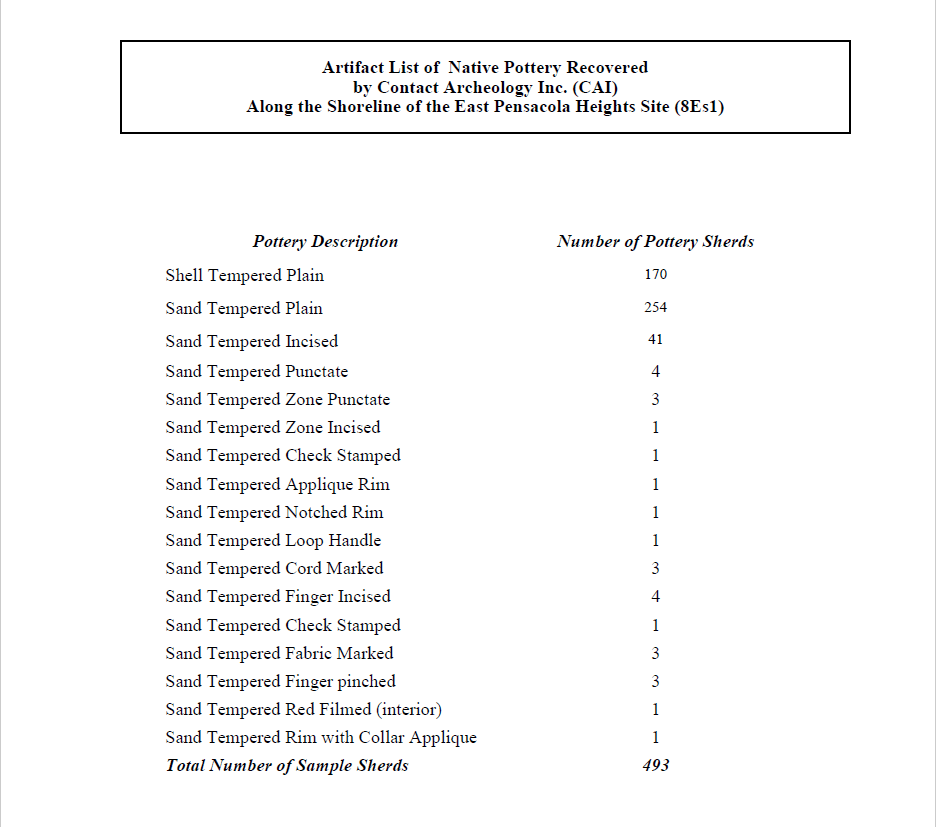
In summary, the archeological confirmation of the Luna Colony necessitates the presence of Spanish burials, structures, firehearths, and possibly refuse pits. After six years of excavations of over a
thousand units UWF has not reported these necessary constructs for the presence of the Luna Colony.
Although numerous news articles and papers presented at archeological conferences have been touted, no comprehensive technical report is available. CAI has made multiple attempts to obtain all data from this archeological site for review, but has consistently been denied access by UWF, even after Freedom of Information Act requests were officially presented to UWF.
It is a professional imperative that UWF provide a traditional technical archeological report of their recovered field data. These data should include photos, drawings, and descriptions of features, stratigraphy, and field activities as well as artifact tables of all artifacts recovered, including both Native and Spanish. UWF has failed to do so.
Astoundingly, UWF has published documents that provide readers with imagined overlays of the Luna Colony on the Native site. These imagined overlays include Spanish “activity areas,” “a boat landing,” and even “schematic layouts of lots.” No definitive archeological data has been provided to support these “imaginings” even though news releases and conference presentations continue to disseminate them as proven fact. (See, “Functional and Spatial Patterning in Artifact Distribution at the Luna Settlement Site,” by UWF John E. Worth, Florida Anthropological Society, Crystal River, Florida, May 11, 2019).
There has been too much “imagination” and not enough objectivity applied to the interpretation of this important and complicated site on Pensacola Bay. The East Pensacola Heights Site deserves the utmost objective scientific and journalistic scrutiny to determine its history and prehistory … be it the Luna Colony or not.
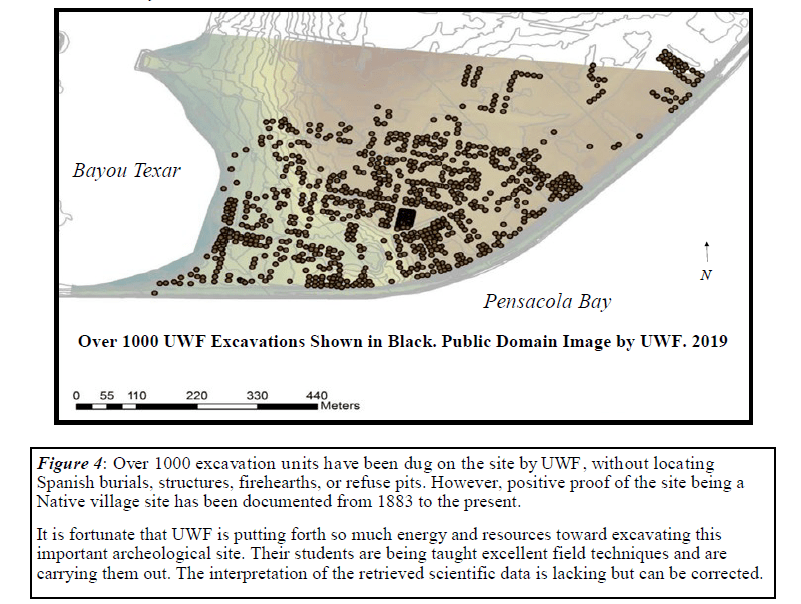
- Article
-
The first mission of a newspaper is to tell the truth as nearly as the truth may be ascertained.
The Washington Post.Archaeology is not what you find, it’s what you find out.
The American Museum of Natural History.The public is influenced by news reporting, be it accurate, partially accurate, or altogether false. That reality has been demonstrated throughout history and into the present. When journalism loses its objectivity it
ceases to become journalism and morphs into promotialism. Scientifically, when research is conducted based on a preconception of the outcome and ignoring the data recovered … it becomes invalid.Beginning in 2015 a number of local news media became aware of the University of West Florida (UWF) claim that the East Pensacola Heights Site (8Es1) is the location of the Luna Colony. The Pensacola News Journal (PNJ) published articles claiming that UWF had unquestionably found the site of the 1559 Luna Colony. The following is a sample list of the PNJ titles of their articles. The PNJ author of these and other
articles subsequently became an employee of UWF in 2017 under the title of “News and Publicity Director for Institutional Communications.”“ We Found Luna’s Colony” 12/18/2015.
“Neighbors excited to be part of Luna history” 12/18/2015.
“Don Tristan de Luna Settlement, Historic Discovery” 12/20/2015.
“It’s a Crowning Achievement for UWF president” 12/20/2015.
“Archaeologist ‘Worth’ every penny for UWF” 12/20/2015.
“Luna Site is in the Spotlight” 1/7/2016.Even The New Yorker magazine joined the promotional effort to publicize the UWF alleged Luna Colony discovery (4/9/2016). Their article was entitled “Uncovering the Luna Colony, A Lost Remnant of Spanish Florida.”
These articles from local and national media were prematurely published prior to conclusive scientific data that would prove or disprove the UWF claim. True scientific inquiry is not determined in newsrooms with deadlines pushing for dramatic stories to sell the news, rather, scientific inquiry is conducted based on the rudimentary concept of hypothesis development and testing. A hypothesis is a tentative assumption made in order to draw out and test its logical or empirical consequences. UWF and the news media have not adhered to this process.
True scientific inquiry is slow, methodical, cautious, and deliberate. Viable hypotheses are developed in labs, libraries, internet searches, debates with colleagues, round table discussions, emails, and peer reviews. The hypotheses are then rigorously tested through fieldwork and objective interpretation of data recovered. The UWF policy of presenting premature papers at numerous archeological conferences around the country does not equate to publishing a detailed technical report of six years of UWF fieldwork at the East Pensacola Heights Site supported with indispensable facts.
While it is true that UWF has recovered an impressive array of 16th-Century Spanish artifacts on their alleged Luna Colony site, it is certainly not clear how the artifacts arrived there. The Smithsonian Institution during the late 1800s and again in the 1940s noted that the site was a Native village with two burial mounds and occupational midden remains. Which group brought the Spanish artifacts to the site? Natives? Spanish?
A reasonable hypothesis is that the Spanish artifacts were brought to the Native village through trade and / or salvage by the Natives themselves during and before the Luna Expedition. Another hypothesis is that the Spanish artifacts could even have been left by Spanish salvors camped on the site while they attempted to recover objects from their three unanchored shipwrecks just offshore.
Archeological evidence of the settlement plan of the Viceroy of Mexico for the Luna Colony has not been found at the site. Remains of a church, a graveyard, a king’s warehouse, a plaza, and Spanish domestic structures, all required for proof of the Luna Colony, have not been reported from the East Pensacola Heights Site. Conversely, Native burial mounds, middens, pottery, and burials have been found. Thus far, the archeological evidence of a Native village at the site outweighs that of the Luna Colony.

Figure 1: Natives viewing Spanish sailing ships from their village area.
Courtesy of Parris Island Museum.UWF added credence to this Native village reality by noting that approximately 70% of pottery sherds excavated by them from portions of the site were Native in origin (See “Functional and Spatial Patterning in Artifact Distribution at the Luna Settlement Site,” by UWF John E. Worth, Florida Anthropological Society, Crystal River, Florida, May 11, 2019). Nonetheless, UWF continues to “declare” that the site is the Luna Colony.

Figure 2: Artist illustration of divers salvaging a 16th-Century Spanish shipwreck on the coast of Texas. Courtesy of the Texas Antiquities Committee. 

Figure 3: Photographs of a sample of Native ceramics recovered by CAI personnel along the eroded shoreline of the East Pensacola Heights Site (artifact list on following page). The Native ceramics date from the Woodland and Mississippian Periods (Santa Rosa / Swift Creek, Weeden Island, Ft. Walton, and Pensacola) including the period of the Luna Expedition in Pensacola Bay.
The importance of the ceramics indicates that the site was used as a village, either permanent or seasonal, by generations of Native groups as confirmed by the research of the Smithsonian, CAI, and UWF. The Native people likely traded with European sailing expeditions during first contacts of the 1500s and perhaps salvaged artifacts from the three Luna shipwrecks that washed upon the adjacent shallows during the hurricane of 1559.
Based on the fact that the site was definitely a Native village, it is inappropriate to jump to the conclusion that the site is the Luna Colony. Rather, hypotheses should be developed and tested. Three of these hypotheses include:
Hypothesis #1: The site is the Luna Colony.
Necessary Proof: Spanish burials, structures, firehearths, refuse pits.Hypothesis #2: The Spanish artifacts at the site came from trade and salvage by the Native inhabitants.
Necessary Proof: Lack of Spanish features. Only Native features present. Spanish artifacts scattered amongst Native artifacts.Hypothesis #3: The Spanish artifacts found came from a short-term Spanish shipwreck salvors camp.
Necessary Proof: Lack of numerous Spanish features. Spanish artifacts scattered amongst Native artifacts.
In summary, the archeological confirmation of the Luna Colony necessitates the presence of Spanish burials, structures, firehearths, and possibly refuse pits. After six years of excavations of over a
thousand units UWF has not reported these necessary constructs for the presence of the Luna Colony.Although numerous news articles and papers presented at archeological conferences have been touted, no comprehensive technical report is available. CAI has made multiple attempts to obtain all data from this archeological site for review, but has consistently been denied access by UWF, even after Freedom of Information Act requests were officially presented to UWF.
It is a professional imperative that UWF provide a traditional technical archeological report of their recovered field data. These data should include photos, drawings, and descriptions of features, stratigraphy, and field activities as well as artifact tables of all artifacts recovered, including both Native and Spanish. UWF has failed to do so.
Astoundingly, UWF has published documents that provide readers with imagined overlays of the Luna Colony on the Native site. These imagined overlays include Spanish “activity areas,” “a boat landing,” and even “schematic layouts of lots.” No definitive archeological data has been provided to support these “imaginings” even though news releases and conference presentations continue to disseminate them as proven fact. (See, “Functional and Spatial Patterning in Artifact Distribution at the Luna Settlement Site,” by UWF John E. Worth, Florida Anthropological Society, Crystal River, Florida, May 11, 2019).
There has been too much “imagination” and not enough objectivity applied to the interpretation of this important and complicated site on Pensacola Bay. The East Pensacola Heights Site deserves the utmost objective scientific and journalistic scrutiny to determine its history and prehistory … be it the Luna Colony or not.

- Download PDF Version